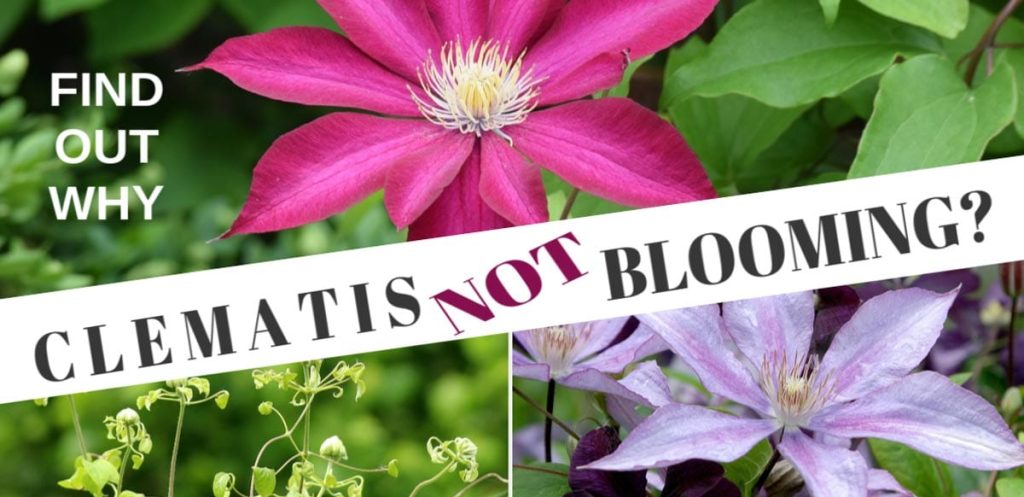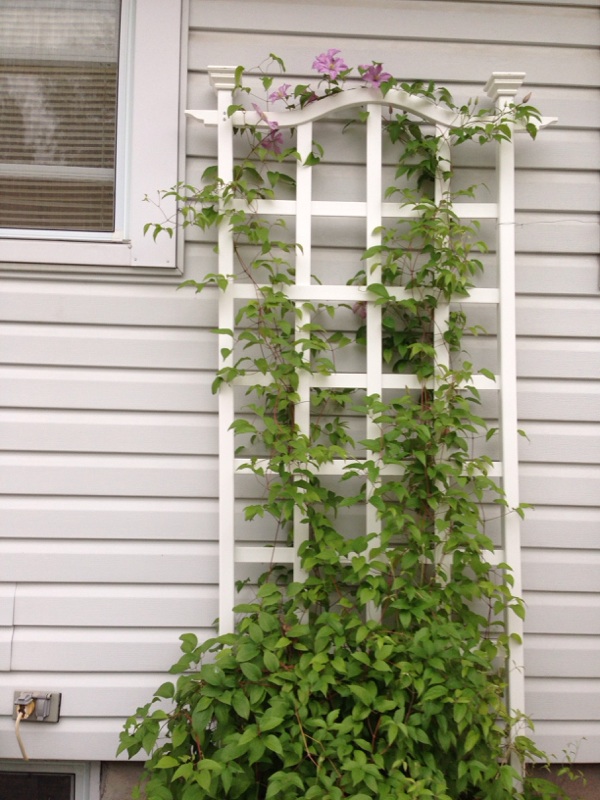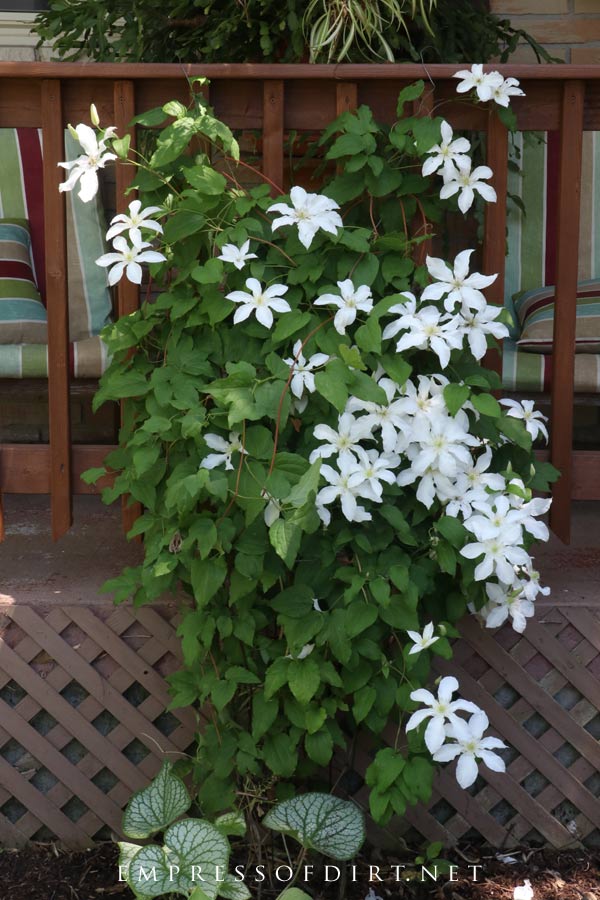
The hardy perennial climbing vine known as clematis comes in a wide variety of cultivars and blooms throughout the season, usually in late spring and early summer.
There are a number of reasons why your clematis might not be blooming in the summer.
The two most frequent causes of clematis not blooming are using too much fertilizer and springtime cutting of the budding flower buds off the vines. To produce flowers, clematis needs rich, well-draining soil that is consistently moist, a cold root system, and full sun.
| Causes of Clematis’s Lack of Flowering | The Conditions for Flowering |
| inadequate soil conditions | Poor soil makes it difficult for clematis to flower. For clematis to flower, nutrient-rich loam soil or soil that has been amended with organic matter are ideal. |
| Too much sun at the roots and too much shadow on the vines: | While the clematis vines and foliage need full sun for flowering and produce fewer blooms in the shade, the roots at the base of the plant prefer shady, cool, wet soil. |
| Overuse of Fertilizer: | Fertilizer that is applied too frequently or in excess concentration encourages the growth of luxuriant foliage but results in fewer flowers on your clematis. |
| Pruning at the Inappropriate Season: | Hard trimming in the spring removes the growth from which the flower buds form since some clematis kinds flower on the growth from the previous season. Clematis should always be pruned and shaped soon after blossoming. |
| Drought Pressure | Clematis needs wet soil all year round in order to form buds and produce flowers in the summer. Your clematis may droop under the strain of drought at different times of the year, which is bad for the growth of flower buds on the vines. |
Continue reading to find out why your clematis isn’t blooming and to discover the best methods for guaranteeing a healthy bloom the next Spring.
Table of Contents
Soil Conditions Required for Clematis Flowering
Rose bushes and clematis both require comparable soil conditions for flowering.
The ideal soil types for clematis are:
- soil that drains well and doesn’t retain moisture or hold too much.
- Loam soils that are rich in nutrients or in organic materials.
- a permeable but consistently moist soil that the roots can access when they need moisture.
Your clematis’ failure to bloom may simply be a result of the unfavorable soil conditions.
To guarantee your plant gets the resources necessary for flowering, it is crucial to thoroughly prepare the soil before planting clematis (by amending the soil with tons of compost) (nutrients, soil structure and moisture).
If your soil is sandy, it will drain too rapidly and not hold on to enough nutrients that are water soluble for growth.
The soil structure can also restrict root growth and retain too much moisture if the soil is thick with clay or low lying and swampy, which causes issues like clematis wilt.
Clematis flourish in any soil that has been treated with organic matter (such as compost, leaf mould, and well-rotted manure), as these materials retain moisture, enhance soil structure, and contribute nutrients to the soil, even though loam soil is said to be perfect for producing clematis.
The greatest method for preserving the health of your clematis and promoting flowering is to add mulch around its base each year.
Transplant clematis in the spring to a part of the garden with more suitable soil enriched compost if your soil is excessively sandy, nutrient-poor, or extremely soggy.
In any other case, dig up the clematis from the ground and add heaps of compost and organic matter to the area around the plant so that the soil is better suited for the plant to flower.
Clematis Require Sun on the Plant but Shade at the Roots for Flowering

The clematis vines expand widely in full shade and have an abundance of healthy-looking foliage, but the plant produces few or no flowers.
To encourage flowering, move any shaded clematis to a location with some direct sunlight or prune back overhanging branches and other vegetation that may shade the clematis.
The amazing thing about clematis is that they bloom more profusely when their roots are in the shade and their leaves are in broad sunlight.
While many plants share this trait, clematis have a much larger need for shady roots in order to thrive and bloom.
While their leaves need full sun to produce blossoms, clematis roots prefer chilly, damp soil.
This is simple to accomplish in your garden:
- To provide shade for the region around the roots of your clematis, carefully put bedding or other plants in the soil.
- Mulch the area of soil next to the clemtis.
A 1 inch layer of mulch on the soil’s surface aids in moisture retention and blocks the sun’s rays from directly hitting the surface, preventing the soil from baking in the summer and keeping the roots cool.
Compost, leaf mold, and well-rotted manure are the best mulch materials for clematis since they all have a high ability to hold moisture, keeping the root system cool during the hot summer months.
For the best flowering, mulch the base of your clematis in the spring before the heat of the summer and once more in the middle of the summer.
Too Much Fertilizer Causes Fewer Clematis Blooms
To increase the amount of nutrients accessible, clematis can frequently benefit from fertilizer; nonetheless, it’s crucial to strike the correct mix.
In comparison to competition-standard roses, clematis does not tolerate regular supplementary fertilizer to the same amount.
Foliage is promoted at the expense of clematis blossoms when there is an excess of nitrogen in the soil as a result of fertilizer application that is either too frequent or too concentrated.
In order to produce optimal clematis flowering, a balance is required.
In comparison to established clematis in well-prepared soil, clematis in pots, containers, or possibly soils that have not received mulch for years typically benefit more from additional fertilizer in terms of flowering.
It can be harmful to flowering to apply a high concentration of fertilizer or to use it more than twice throughout the growth season.
Reduce fertilizer use to a half-concentrated application of NPK (nitrogen, phosphorus, and potassium) multipurpose fertilizer in the spring for the best nutrient balance to ensure clematis flowers well the following spring.
Pruning at the Wrong Time of Year (Cuts Away Developing Flower Buds)
Some clematis kinds bloom in the spring on the previous year’s growth, while others bloom on the new growth.
As you might have removed the flower buds that form on the previous year’s growth, pruning clematis in the early spring might encourage the growth of numerous vines and foliage, but not flowers.
The ideal time to cut back and shape your clematis is after flowering, which might happen in late spring or early summer depending on the temperature.
Just after flowering, pruning promotes growth so that the plant will look more arranged and tidy and produce more blooms the following year.
Pruning clematis vines annually prevents them from overlapping and becoming a matted, tangled mess, which can also reduce the number of blooms.
For a demonstration on how to prune clematis, view this YouTube video.
Drought Stress Prevents Flowers

In order to prevent summertime drought stress from harming clematis blooms:
- For clematis to retain moisture, enrich the soil with a lot of organic materials.
- To further preserve soil moisture and guarantee the roots are in shaded soil, add a layer of mulch to the soil around the clematis.
- Once a week, generously immerse the clematis with water (or as often as required to keep the soil consistently moist).
To assess the soil’s wetness, dig a finger-deep hole into the surrounding dirt. The earth should be damp but not saturated.
If the ground is too difficult to attempt this, the soil structure must be improved by adding a lot of compost as mulch to enhance the soil’s texture.
In order to promote the roots to grow and establish in the soil, which increases drought tolerance, make sure to water clematis generously and thoroughly.
By spreading mulch, you can stop water from evaporating off the soil’s surface and away from the roots (which can happen with sun-baked soil).
To make sure the clematis is not suffering from drought stress so it may bloom in the Summer sun, check the soil moisture around it frequently and generously wet it when necessary.
Key Takeaways:
- Too much fertilizer, poor soil, drought stress, trimming off the growing flower buds in the spring, and too much shade on the leaves and flower buds are the causes of clematis not blossoming.
- To flower, clematis needs rich, wet soil, shaded roots, and full sunlight.
- Pruning in the spring can destroy the flower buds from some clematis varieties, preventing them from flowering. Some clematis varieties flower on the least years of growth.
- Plant your clematis in soil that has been treated with compost, in full sun, and with mulch at the base of the plant to keep the root system cool if you want your clematis to flower. If the clematis is in a pot or has poor soil, fertilize it at half strength in the spring when the weather begins to warm. In dry spells, water the clematis, and once it has flowered, shape or clip the vines to avoid removing flower buds.
